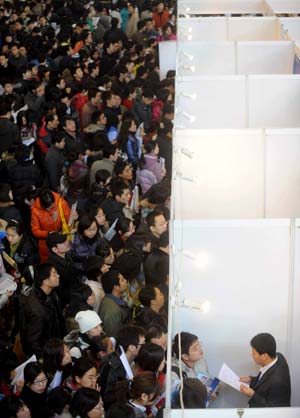Contradiction between China's growth model and graduate aspirations
When Chen Zao entered college in 2001, China had enlarged college rolls four years in a row. In 2009, the number of students on campus was three times higher than in 1999.
 |
|
Students crowd a job fair in Beijing, capital of China, Dec. 14, 2008. More than 20,000 postgraduates visited on Sunday the special job fair which offered over 142,000 positions by more than 700 enterprises.
|
As a Law major Chen Zao is a fair reflection of the breakneck expansion of colleges. In 2007, China had more than 100,000 law students, 447 times larger than the 1977 figure, when there were just 223.
In 2006, when Chen Zao finished her undergraduate studies, around 50 students in her class left college to follow careers totally irrelevant to law. According to MyCOS, more than one third of college graduates that year failed to find jobs suited to their majors. In 2009, even such jobs are precious.
The difficult job situation is largely the result of a contradiction between China's economic development model and the types of posts available in the jobs market on the one hand, and the glut of highly qualified graduates on the other.
In the mid-1990s, China changed its economic growth mode, switching the focus to fixed assets investment and the export business. In this period, state-owned enterprises acquired a dominant position in key industries like finance, energy, transport and high tech innovation.
Private enterprise development, on the other hand, was restricted by difficulties in obtaining funding and unfair market competition. In particular, commercial banks were more willing to lend money to large state-owned enterprises, whose credit ratings were guaranteed by the government.
But in the meantime, state-owned enterprises were losing their capacity to absorb labor. According to MyCOS, China's 110,000 state-owned enterprises will employ less than a quarter of this year's graduates.
Over the past decade, graduate employment has been lagging behind economic growth. The crux of the problem lies in the nation's development strategy. China's fast economic growth is largely stimulated by export-oriented enterprises engaged in the processing business. They are unable to absorb large numbers of college graduates as they rely for their competitiveness on low labor costs. For example, Chen Zao cannot imagine what she might do in a toy export company except administration.